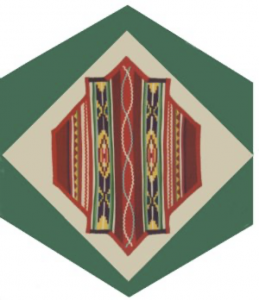Gwich’in

The Block
Block-maker, Olive Itsi, has created a colourful sample of the famous Delta braid used to trim the body, front or sleeve bands of traditional Gwich’in parkas and other clothing. These patterns are created by tightly sewing together overlapping, narrow layers of bright fabrics, further defined with strips of contrasting colours to form secondary and tertiary geometric designs. This is a time-consuming art; in this sample alone, there are 55 layers, plus the additional pieces used to form the patterns.
Cultural Profile
The Gwich’in were originally called the Takudh-Kutchin, which translated into “people with the slanted eyes” in English. They are sometimes classified as Sahtu Dene, and were called “Loucheaux” by French fur traders. Historically, the Gwich’in were made up of many independent families whose activities depended on seasonal migration to take advantage of the natural food resources. Their traditional territory covered about 10,000 square miles of land surrounding the Crow, Yukon and Porcupine Rivers. The main centre of activity is now at Old Crow, Yukon, the most northerly year-round settlement. There, people call themselves “the people who live among the lakes.”
There are approximately 7,000 Gwich’in in scattered towns in northeast Alaska and northwest Canada. The interior subarctic environment is characterized by long, cold winters and very short, warm summers. Bands traditionally reflect several native cultures, including the southern Dene bands, British Columbia coastal natives, and the West Arctic Inuit.
Gwich’in means ‘people of the caribou,’ an appropriate name for people who relied on the caribou for a major part of their spiritual, cultural and economic survival. No part of the animal was wasted. The caribou is still highly esteemed, and it is believed that ‘the caribou knows a little of what man is thinking and man knows a little of what the caribou is thinking.’
Legends teach the importance of not wasting, cooperation and sharing. Many Gwich’in who live in the area of the 130,000 strong Porcupine caribou herd have been instrumental in affecting legislation to protect the herd and its habitat for long-term conservation.
The first Dene member of the territorial council (forerunner of the NWT legislative assembly) was Gwich’in chief John Tetlichi (1967), and Wally Firth was the first northern native MP (1972). The community of Tetlit Zheh (formerly Fort McPherson) is home to the graves of the “Lost Patrol,” four RCMP officers who lost their way and starved to death in 1911.
Sponsor: Gwich’in Teaching and Learning Centre and Irene Poirier, in memoriam from her children
